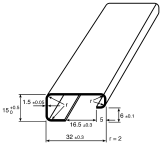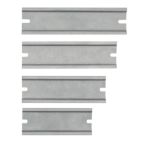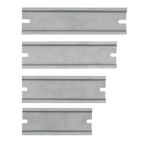DIN Rails
DIN rail is a standardised mounting system widely used for industrial control equipment, particularly within enclosures, racks, and control panels. DIN rails provide a secure and organised platform for mounting various electrical and electronic components, streamlining installation and maintenance. They are designed to conform to European (EN) and international (IEC) standards, ensuring compatibility with a wide range of industrial control equipment.
For more information on DIN Rails, check out our free guide.
Types of DIN Rail
DIN rails are available in various types and sizes to accommodate different applications and mounting requirements. Some common types include:
- Top Hat DIN Rail (EN 50022): Also known as TS35 rail, this 35mm wide DIN rail is a popular choice for industrial control equipment. It comes in 7.5mm and 15mm depths, with slotted and unslotted versions available.
- Miniature Top Hat DIN Rail (EN 50045): This smaller variant, also referred to as TS15 rail, has a width of 15mm and a depth of 5.5mm, making it suitable for compact installations.
- C-Section DIN Rail: With a C-shaped cross-section, this type of DIN rail offers a curved and symmetrical design. Popular sizes include C20, C30, C40, and C50, with the number corresponding to the height of the rail in millimetres.
- G-Type DIN Rail (EN 50035): This DIN rail features a G-shaped cross-section with a curved, asymmetrical appearance.
- Perforated DIN Rail: These rails feature pre-punched holes along their length, allowing for flexible mounting options and easy attachment of components.
- Deep DIN Rail: These rails offer increased depth for accommodating larger or more complex components.
- Stainless Steel DIN Rail: Constructed from durable stainless steel, these DIN rails offer corrosion resistance and are suitable for harsh environments.
Installation Guidelines for DIN Rails
Proper installation of DIN rails is crucial for ensuring the stability and security of mounted components. Here are some best practices to follow:
- Choose the right type and size: Select a DIN rail that is compatible with your components and enclosure.
- Measure and cut accurately: Accurately measure and cut the DIN rail to the desired length using appropriate tools.
- Securely mount the rail: Use appropriate fasteners and mounting brackets to securely attach the DIN rail to the mounting surface.
- Ensure proper alignment: Align the DIN rail properly to ensure that components can be easily mounted and removed.
- Use appropriate mounting clips: Use the correct mounting clips or accessories to securely attach components to the DIN rail.
Maintenance and Durability of DIN Rails
DIN rails are typically durable and require minimal maintenance. However, periodic inspection and cleaning can help ensure their longevity and performance.
- Regular inspection: Inspect the DIN rails for any signs of damage, corrosion, or loose fittings.
- Cleaning: Clean the rails periodically to remove dust, debris, or other contaminants that could affect their performance or cause corrosion.
- Corrosion protection: In harsh environments, consider using DIN rails with corrosion-resistant coatings or materials like stainless steel.
Industry Applications for DIN Rails
DIN rails provide a versatile and standardised mounting solution for a wide range of electrical and industrial components, making them essential in various industries.
- Discrete Manufacturing: DIN rails are extensively used in manufacturing automation, providing a robust and organised platform for mounting PLCs, I/O modules, relays, and other control devices within enclosures and control panels.
- Process Manufacturing: In process industries, DIN rails facilitate the organised installation of sensors, actuators, and control equipment in hazardous areas or challenging environments.
- Energy & Utilities: DIN rails are used in power distribution systems, substations, and renewable energy installations for mounting circuit breakers, relays, and other electrical components.
- Facilities & Intralogistics: DIN rails are commonly found in building automation systems, HVAC controls, and security systems, providing a standardised mounting solution for various components.
Your Trusted DIN Rails Supplier & Manufacturer
RS is a leading supplier and distributor of DIN rails in Australia. We offer a comprehensive range of high-quality DIN rails from top brands, including Schneider Electric, Phoenix Contact, and RS PRO, ensuring you find the perfect solution for your specific needs. Enjoy prompt delivery of your DIN rails and other electrical enclosure accessories, such as pluggable terminal blocks, across Australia. For more details on delivery services and fees, please refer to our Delivery page.
Popular Searches
Related links
- RS PRO Steel Slotted DIN Rail 1m x 35mm x 15mm
- RS PRO Steel Slotted DIN Rail 1m x 35mm x 7.5mm
- RS PRO Steel Perforated DIN Rail 500mm x 35mm x 15mm
- DIN Rail Enclosures
- RS PRO Steel Unperforated DIN Rail 2m x 35mm x 15mm
- RS PRO Steel Slotted DIN Rail 1m x 15mm x 5.5mm
- Fibox Steel DIN Rail 210mm x 35mm x 1mm
- RS PRO Steel Unperforated DIN Rail 1m x 35mm x 7.5mm



















